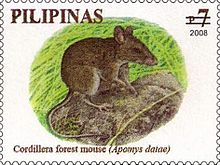Apomys datae
| Luzon montane forest mouse | |
|---|---|
 |
|
| Scientific classification | |
| Kingdom: | Animalia |
| Phylum: | Chordata |
| Class: | Mammalia |
| Order: | Rodentia |
| Family: | Muridae |
| Genus: | Apomys |
| Species: | A. datae |
| Binomial name | |
|
Apomys datae (Meyer, 1899) |
|
 |
|
| Range of the Luzon montane forest mouse on global scale | |
 |
|
| Range of the Luzon montane forest mouse within the Philippines (blue) | |
The Luzon montane forest mouse (Apomys datae) is a species of rodent in the family Muridae, from the genus Apomys. It occurs only in the Philippines, where it has been found on the large northern island Luzon (in the Cordillera Central and on the coast of Ilocos Norte). It is most closely related to the large Mindoro forest mouse, which occurs on Mindoro. There may be another related species in the Sierra Madre, but this species is yet undescribed. The Luzon montane forest mouse is a relatively large, ground-dwelling rat with a tail that is quite short for its genus.
The Luzon montane forest mouse was the first species of Apomys ever to be discovered. In 1895, an expedition was organised which brought to Europe the first specimens of several genera, including Carpomys, Rhynchomys and Crunomys. During this expedition, in February, England explorer John Whitehead captured a number of unknown rats on a site called Lepanto on Mount Data, at an altitude of approximately 2,500 m (8,200 ft). In 1898, British biologist Oldfield Thomas described these animals as an "interesting species", but identified them as Mus chrysocomus, a species from Sulawesi that is now known as yellow-haired hill rat (Bunomys chrysocomus) and reckoned among the genus Bunomys, which is not actually closely related to Apomys. Thomas sent a specimen to the Staatliches Museum für Tierkunde Dresden, where Adolf Bernard Meyer concluded that the animal did not resemble Mus chrysocomus. Meyer described th animal as Mus datae in 1899, after its type locality – Mount Data (at the time the generic name Mus was used more broadly than it is now). For a long time, little was known about Mus datae, until 1913, when American biologist Ned Hollister described eight rats from Luzon under the name Epimys datae ("Epimys" was the name of the genus that would later become Rattus). These were in fact examples of the Himalayan field rat (Rattus nitidus), but they were only identified as such in 1977, by Guy Musser, another American biologist. Meanwhile, in Britain, John Ellerman had finally placed Mus datae with its relatives in Apomys, in 1941. Eleven years later, in 1952, American zoologist Colin Campbell Sanborn announced that he had captured 54 specimens of A. datae on Mount Data. A good part of this catch, however, was later found to consist of specimens of the Luzon Cordillera forest mouse (A. abrae), a species which had been described by Sanborn in the same article in which he had made his announcement.
...
Wikipedia

